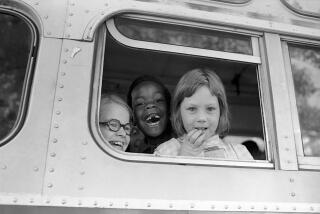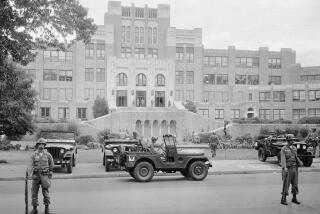Elizabeth Huckaby; Chronicled Integration
- Share via
Until Sept. 25, 1957, the only black people Elizabeth Huckaby had known were maids and other household helpers. But on that day 42 years ago, Huckaby, an English teacher and administrator at Central High School in Little Rock, Ark., became protector of nine black children chosen to integrate Arkansas’ largest public school. In so doing, she became a pivotal figure in a historic civil rights confrontation.
Huckaby, who died March 18 in Little Rock at age 93, later wrote a memoir of the tumultuous year she spent at the center of the hostilities, “Crisis at Central High--Little Rock 1957-58.”
A native Arkansan, Huckaby said in a 1981 interview that the Central High administration had known for some time that the black students were coming. School officials thought integration would stir only minor opposition.
“That was a big mistake,” Huckaby, who taught at Central High almost 40 years, recalled with a grim smile.
The Supreme Court had rendered its landmark decision banning segregated public schools in the 1954 Brown vs. Board of Education case. Three years later, the issue exploded in Little Rock, turning its high school into an armed camp.
In the first chapter of her memoir, Huckaby wrote that she was glad to be involved in Central High’s integration. “Like many Southerners--a larger number than was at first evident--I felt the decision of the Supreme Court . . . had been eminently fair and just; that no public school system segregated by law on the basis of race was consistent with democracy.”
But on the first day of school in 1957, Huckaby, who was girls’ vice principal, found the campus ringed by the National Guard, dispatched by Gov. Orval E. Faubus to keep the black students out. Segregationists from the community and elsewhere also had amassed outside the school.
To ensure the black students’ entry, President Dwight Eisenhower sent 1,000 bayonet-wielding Army paratroopers to Little Rock and placed the Arkansas National Guard under federal control.
“This had been my school since 1930,” Huckaby wrote. “Now I felt like a foreigner.”
School officials had thought that desegregating the school would be easiest if it happened gradually, Huckaby said. That is why only nine black students were chosen the first year to integrate a school of nearly 2,000 whites.
But at one point on the first day, Huckaby found herself staring down a mob of 50 students yelling epithets at the black students as they entered the school.
Huckaby and the other administrators withstood almost daily bomb threats during the first year of integration. Decades later, Huckaby still suffered from an ulcer she developed during that stormy period.
Only a fraction of the student body--50 to 75 students--was openly bigoted, Huckaby later said. That contingent, however, was “a very powerful minority.”
She did not stay in touch with the nine black students. But one of them, Ernest Green, became assistant to the secretary for employment and training in the Jimmy Carter administration.
Huckaby maintained an almost daily diary of Central High’s integration but, fearing for her job, did not attempt to find a publisher until after she retired in 1969. By then, so much time had lapsed that no publisher was interested in the event.
In the late 1970s, however, a producer stumbled across a copy of her manuscript and thought it was ripe for a movie treatment. Huckaby contacted Louisiana State University Press with the news that one of the school’s more illustrious graduates, Joanne Woodward, wanted to portray her.
In 1980, Louisiana State published her memoir. In 1981, Woodward earned an Emmy nomination for her portrayal of Huckaby in a CBS television movie.
Huckaby is survived by a sister, Clara Doyle of Danville, Calif., and a brother, Clifton Paisley of Tallahassee, Fla.
More to Read
Sign up for Essential California
The most important California stories and recommendations in your inbox every morning.
You may occasionally receive promotional content from the Los Angeles Times.














